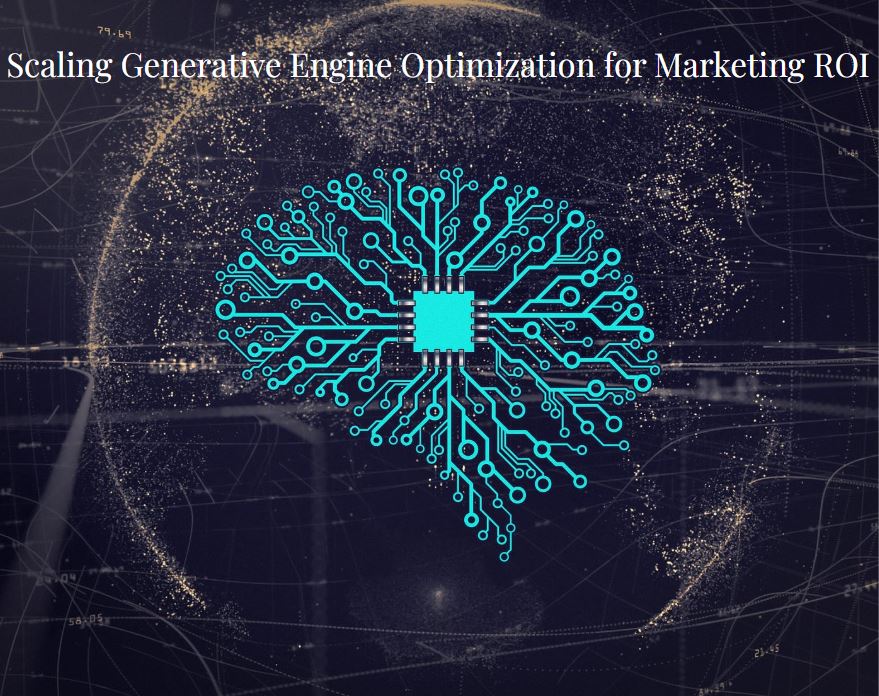
Scaling Generative Engine Optimization for ROI
In today’s rapidly evolving digital landscape, staying ahead of marketing trends is crucial for businesses seeking to maximize their return on investment. One of the most transformative shifts in recent years is the emergence of generative artificial intelligence and its impact on how users discover, interact with, and trust content. Generative Engine Optimization, or GEO, has become a pivotal strategy for marketers aiming to enhance visibility and effectiveness in this new environment. GEO focuses on optimizing content specifically for generative AI systems such as ChatGPT, Google Gemini, and other large language models that increasingly mediate how information is accessed online.
Basic Elements of Constructing GEO ROI
Maximizing digital marketing ROI with GEO starts with understanding the shift in user behavior. Instead of relying solely on traditional search engines, users are now turning to conversational AI tools to find answers, get recommendations, and explore topics. These tools often bypass conventional search engine result pages and provide direct responses synthesized from multiple sources. This change means that marketers must craft content that is not only indexed by these AI models but also frequently selected as a reliable and authoritative source. To position content favorably within AI-generated outputs, marketers must embrace a new approach to content strategy. This involves creating resources that are comprehensive, contextually rich, and written in a natural, conversational tone. The aim is to anticipate user queries and provide clear, direct answers that AI systems can easily extract and present. Rather than focusing on exact-match keywords, GEO prioritizes semantic relevance. Marketers should understand the broader intent behind user searches and create content that thoroughly addresses those needs in a way that mimics natural human dialogue.
Content structure plays a critical role in GEO. Unlike traditional SEO, where technical factors like backlinks and meta tags dominate, GEO emphasizes clarity, logical flow, and completeness. Marketers should structure their content to include common user questions, followed by concise yet informative responses. This approach not only makes content more user-friendly but also aligns with how AI systems scan and synthesize information. The inclusion of clearly defined headings, subheadings, and contextual transitions enhances the model’s ability to identify key pieces of information quickly. Another essential component of GEO is the use of structured data. Structured data, such as schema markup, allows content to be tagged in a way that provides explicit context to AI models. This helps generative engines understand the relationships between different parts of your content and increases the likelihood that it will be selected for inclusion in AI-generated responses. For example, using schema to identify FAQ sections, product information, or how-to guides can significantly improve content discoverability within AI platforms.
Monitoring and optimization are continuous elements of a successful GEO strategy. Just as SEO requires ongoing attention to keyword trends and algorithm updates, GEO demands regular analysis of how content performs in generative outputs. Marketers should frequently test their visibility by posing relevant queries to AI assistants and observing which sources are cited. If a brand’s content is not being surfaced, adjustments should be made to improve clarity, relevance, or depth. Additionally, insights from AI performance can inform broader content strategy, revealing gaps and opportunities in existing resources. Investment in high-quality content creation is more important than ever. With generative AI systems drawing from a wide array of data, only the most authoritative, well-written, and clearly structured content tends to be featured. This places a premium on subject matter expertise, editorial precision, and user-centric communication. Brands that invest in detailed guides, thought leadership, and helpful resources will find themselves cited more often by AI, leading to increased exposure and higher engagement. Integrating GEO into broader digital marketing efforts also involves collaboration between content creators, SEO professionals, and data analysts. These teams must work together to ensure that GEO principles are applied consistently across all digital properties. This includes website content, blog posts, product pages, and even multimedia assets. A unified approach enhances the brand’s authority and makes it easier for AI systems to recognize and recommend its content across different contexts.
Measuring the ROI of GEO efforts requires a slightly different approach from traditional SEO metrics. While tracking rankings and organic traffic still matters, marketers should also evaluate how often their content appears in AI-generated responses. This can be gauged through user feedback, AI query testing, and indirect referral patterns. Over time, increased visibility through AI systems can drive more qualified traffic, longer engagement times, and higher conversion rates. These indicators, when tied back to specific GEO strategies, provide a clear picture of return on investment. The future of digital marketing will increasingly depend on how well brands adapt to the generative AI paradigm. GEO offers a practical framework for aligning content strategy with this technological evolution. By focusing on semantic clarity, structured data, conversational tone, and continuous optimization, marketers can position their content to be favorably represented in AI-generated outputs. This not only enhances brand visibility but also drives meaningful engagement and long-term value, delivering a strong return on marketing investment. In conclusion, Generative Engine Optimization is not just an adaptation of traditional SEO but a forward-thinking strategy that addresses the realities of how people find and consume information today. As generative AI becomes more integrated into daily life, the brands that master GEO will be the ones that capture attention, build trust, and ultimately achieve superior results in their digital marketing efforts.
Common GEO Mistakes that Waste Marketing Money
As more businesses embrace Generative Engine Optimization to enhance their visibility in AI-generated content, a growing number of marketing teams are making costly mistakes that undermine their return on investment. These mistakes not only diminish the effectiveness of GEO efforts but can also lead to wasted budgets, missed opportunities, and reduced brand credibility. Understanding these pitfalls is critical for any organization looking to leverage GEO as a key part of its digital marketing strategy. One of the most common mistakes is treating GEO like traditional SEO without adapting to the unique ways generative AI systems retrieve and present information. Many marketers continue to prioritize outdated keyword strategies, overloading content with search terms rather than focusing on the intent and context behind user queries. Generative models do not rank content in the same way search engines do. Instead, they synthesize responses based on semantic understanding. As a result, content that lacks conversational clarity or fails to address real user questions often gets ignored by AI systems.
Another frequent error is producing content that is too shallow or surface-level. In an attempt to cover more topics quickly, some brands publish a high volume of low-quality articles that lack depth or actionable insights. Generative AI engines favor comprehensive, well-organized content that offers real value. Shallow content not only risks being overlooked but also undermines brand authority when users receive vague or repetitive answers that do not solve their problems. Failing to use structured data properly is another costly misstep. Schema markup provides context to both search engines and generative AI systems, helping them understand the structure and relevance of your content. Marketers who neglect to implement or correctly configure schema risk having their content misinterpreted or ignored entirely. This is especially problematic for sites that rely on detailed guides, FAQs, or product information, where structure plays a key role in discoverability.
Many teams also overlook the importance of regularly testing their content in generative AI tools. Without routine checks, marketers cannot know how or if their content is being surfaced in AI-generated responses. This lack of feedback prevents timely adjustments and can lead to a disconnect between what a brand is publishing and what users are actually seeing. Testing should be an ongoing process, guiding iterative improvements and helping content creators identify what works best for generative platforms. Over-reliance on automation tools is another trap that can erode GEO performance. While AI writing tools can be helpful for initial drafts, relying on them to produce final content often results in generic, repetitive, and uninspired material. Generative AI values content that reflects expertise, authenticity, and clear human intent. Marketers who fail to infuse their content with original thought and relevant context risk being filtered out in favor of more authoritative or engaging sources. A lack of cross-functional collaboration can also weaken GEO results. When SEO specialists, content creators, and data analysts operate in silos, opportunities to align goals and insights are lost. For GEO to be effective, teams need to work together to ensure that content not only meets technical standards but also resonates with users and performs well across platforms. Disconnected workflows can lead to inconsistent messaging, poor user experience, and underperforming campaigns.
Misjudging the timeline for GEO results is another source of wasted investment. Some marketers expect instant visibility and ROI from their optimization efforts, not realizing that generative engines take time to absorb and prioritize new content. This impatience often leads to abrupt shifts in strategy or abandonment of GEO initiatives before they have a chance to gain traction. Real success with GEO requires a long-term commitment and a willingness to refine and iterate based on emerging data. Finally, ignoring brand tone and trust signals can sabotage GEO strategies. Generative AI systems are more likely to highlight content that appears credible, consistent, and authoritative. Content that lacks a clear voice, factual accuracy, or relevant attribution may be perceived as unreliable. Brands that overlook the importance of tone, citation, and consistency risk being sidelined in AI outputs in favor of more polished or professional competitors. In the race to optimize for generative AI, avoiding these common mistakes can mean the difference between gaining valuable exposure and wasting significant marketing resources. By understanding the distinct demands of GEO and aligning content strategy accordingly, marketers can ensure that their efforts lead to meaningful engagement, stronger brand presence, and a higher return on digital investments.

